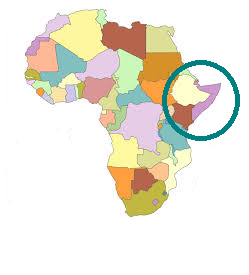To put it simply, Fuzzy and I
have a vision of seeing a disciple-making movement overtake the Horn
of Africa as more and more Somalis become followers of Jesus. Walk
with me as I break this down into more detail.
Let's start with Where are we going?
The
Horn of Africa is the most eastern part of Africa that sticks out into the
ocean like a rhinoceros horn. It is sometimes known as the "Somali
Peninsula," touching the Red Sea, The Gulf of Aden, and the Indian Ocean.
It includes the countries of Ethiopia, Eritrea, Djibouti, Somalia, and Northern
Kenya.
This
is all a bit confusing, I know! The most important thing to remember is that
Somali, Somaliland, Puntland, and the general region of the Horn of Africa is
that the tribes and clans are truly the ones who control the area. All of the
borders you see on typical maps are not often recognized or upheld by the local
people.
The clan elders and their relationships with other clans determine reign and rule
in the region. What land belongs to what clan can change if there is a conflict
between the clans. This brings us to our next point:
Who are Somalis?
Somalis are the people who descend from the Somali
region of the Horn of Africa. There are many Somali people around the world,
most of whom started out as displaced people or refugees who fled from civil
conflict taking place in Somalia.
Depending on who you talk to, "Somali"
is made up of the Somali words "soo" and ‘maal," meaning "go
and milk," referring to their camels, goats, or cows. Though like much of
Somali culture, that too is disputed! Some say "soo" and "maal" mean "from fortune," pointing
out that Somalis have a lot of wealth in their herds. Either way, both
definitions allude to the Somali people and their herds. They are well known
for their herds of camels. They come from a background of being nomadic
herders, taking their animals to where there is grass and water. Now, there are
more traditional cities and villages, and the people are generally more settled
and only send their herds out close to home.
The Somali tribes are made up of five prominent clans.
As previously mentioned, the clans make up the central part of Somali culture
and politics; the clan leaders rule and reign. Clan ties are passed down from
the father.
The majority of Somalis are Muslim. Historically
they have been called the "Protectors of Islam." Though they follow
the teachings of Muhammad, most also put their faith in sheik's or medicine
men, who make amulets, often using the verses of the Qur’an as spells for
protection. This need for security is based on their fears of the evil eye or
curses from others.
These deep Islamic roots bring us to What?
What exactly is the goal of moving to this region
and spending so much time learning the culture and the language? Our goal is to
see a disciple-making movement among the Somali people. Our biggest hope and
prayer is that Somalis will give their hearts to Jesus and surrender to
following Him, becoming a disciple who shares this new faith with others.
When we say disciple, we mean both the noun and
verb form. We want to see devout disciples who desire to study the ways of Jesus,
take on and embrace their new identity in Him and follow in His footsteps by
encouraging and raising up others who also desire to follow Him.
How?
How are we going to see this movement happen?
First, we pray! We cannot make any plans that will force this to occur among
these people in this region- Only the Father can soften their hearts, open their
minds, and give them ears to hear the True Gospel! We have, and we will
continue to posture our heart toward the Father, lean on Him, listen closely
for His voice, and follow His leading as we take steps toward this goal.
If you’d like to learn more details about how we are going about this, sign up for our newsletter!





Thank you, Fiona. This post is very informative and clears up a lot of questions. I feel better equipped to pray with understanding, for you (both) and for those you’re called to love.
ReplyDelete